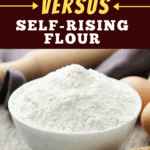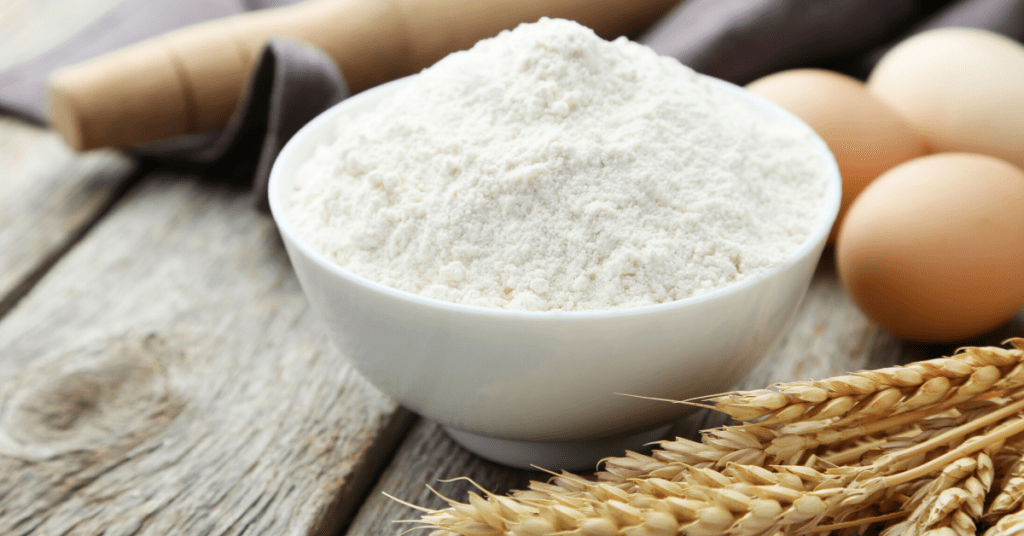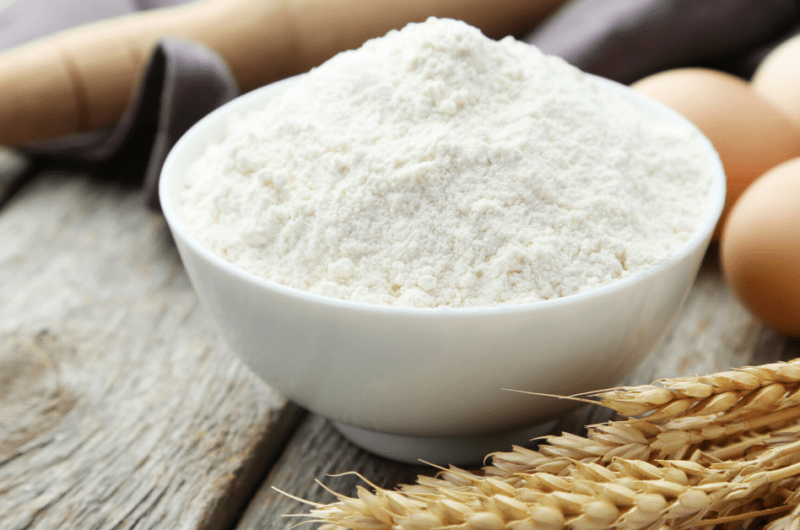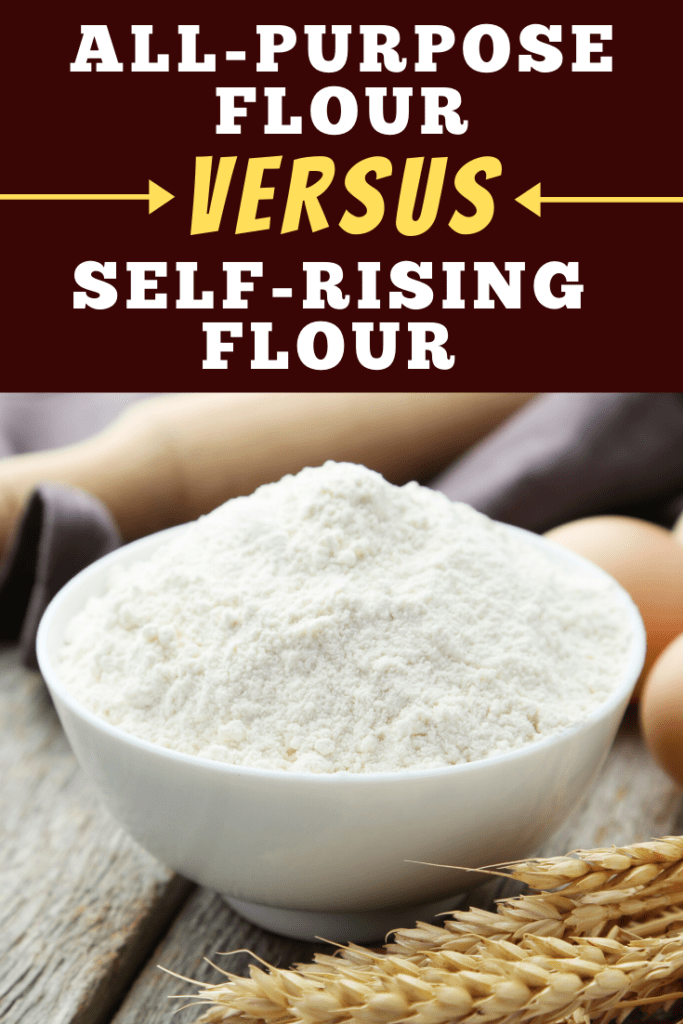Have you ever been in the mood for baking muffins, and your chosen recipe calls for self-rising flour, but you only had all-purpose flour in the pantry? You may have been confused and asked yourself, “Can I interchange the two, or would that mess things up?” Well, your confusion ends right here! Today, we’ll explain the differences between all-purpose and self-rising flour. We’ll cover their specific uses as well. Plus, we’ll even give you a simple recipe on how to convert all-purpose flour into self-rising flour!
What is All-Purpose Flour?
The aptly named all-purpose flour is perhaps the most versatile and commonly used flour out there. I use it for everything, whether it’s baking sweet desserts or coating savory meats. Flour is made by milling together soft and hard wheat. But while it is considered a wheat product, it barely has fiber in it. That’s because it has gone through a complex refinement process, in which the bran and germ in the wheat are removed, along with its healthy fats, antioxidants, and phytochemicals. Essentially, you’re just left with the endosperm of the wheat, which doesn’t have any nutritional value. To make up for it, the flour is enriched with nutrients such as riboflavin, iron, niacin, and thiamine. One good thing about the refinement process is that it gives all-purpose flour a rather long shelf-life. It will keep well for 8 months at room temperature, one year in the fridge, and up to two years in the freezer.
What is Self-Rising Flour?
Self-rising flour, like all types of flour, is made from wheat with low protein. It contains 8% of protein, unlike all-purpose flour, which has around 10-12%. Self-rising flour is commonly used in the South because it is the land of low-protein wheat. Just like all-purpose flour, self-rising flour is also enriched with nutrients. Plus, it contains salt and baking powder, which is what gives it its self-rising ability. So, even if you only use self-rising flour, minus the baking powder, soda, or yeast, expect whatever pastry you are baking to lift. Because of this specific function, you can’t substitute self-rising flour for other flours. Another difference between self-rising and all-purpose flour is its shelf-life. Since self-rising flour has a leavening agent, it has a much shorter lifespan than all-purpose flour. After 4-6 months, the baking powder will start to lose its potency, and it may not cause baked goods to rise anymore.
What is Self-Rising Flour Used For?
If you love making muffins, cupcakes, cakes, cornbread, and other baked goodies, self-rising flour is your best friend. With self-rising flour, there’s no need to worry about getting baking powder or baking soda anymore. It will get the job done effortlessly. Make fluffy pancakes by only using self-rising flour, eggs, and milk! You can also use it to make bread, pizza dough, and biscuits. Again, there’s no need to add a leavening agent to give them that lift. You may also use self-rising flour instead of all-purpose flour, but be mindful of the required leavening ingredients in the recipe. Since self-rising flour already has that taken care of, you don’t need to add baking powder and salt into the mix. The ratio of baking powder and salt per cup of self-rising flour is 1 and ¼ teaspoon, respectively. So, if the recipe calls for a cup of all-purpose flour, 1 teaspoon of baking powder, and ¼ teaspoon of salt, you may use self-rising flour, minus the baking powder and salt. If the recipe calls for more baking powder and salt than what the self-rising flour contains, just add accordingly to compensate. Now, if the recipe calls for baking soda, don’t omit it. Baking powder and soda may both be leavening agents, but they do have different chemical properties. This means that you can’t just substitute one for the other.
What is All-Purpose Flour Used For?
Just by its name, you already know how versatile this flour is. You can basically use it for any recipe that calls for flour! All-purpose flour is great for any baked goods. Whether it’s cookies, cupcakes, muffins, cakes, brownies, or pie crusts, you can count on it for sure. Add a teaspoon of baking soda or baking powder for every cup of all-purpose flour to make your pastry rise. It’s also an essential ingredient in savory dishes! Need to thicken your soup, casserole or gravy? Make a slurry by diluting a tablespoon of flour in half a cup of water, add it into the mix, and stir until thick. If your meats and veggies need some coating from deep-frying, all-purpose flour is there for you, too! Some people do not recommend using all-purpose flour to make bread, though. Since all-purpose flour contains very little gluten, your end product won’t have as much chew as if you use bread flour. Based on personal experience, however, my bread still turned out fantastic! So this one is your call.
How to Make Self-Rising Flour Out of All-Purpose Flour
If all you have is all-purpose flour, but your recipe calls for self-rising flour, there’s no need to head to the grocery store. With just some baking powder and salt, you can transform your flour in no time. Just keep in mind that self-rising flour has a lower protein content than all-purpose flour. So, whatever you are making may not be as tender if you use all-purpose flour. It will still be as yummy, though! It’s not rocket science, folks! Just mix in a teaspoon of baking powder and ¼ teaspoon of salt to all-purpose flour and voila, you have self-rising flour. Accurate measurement is key here, though, so it’s better to measure your flour with a scale than with a cup. If you don’t have one, don’t use your measuring cup to scoop the flour. Instead, add the flour into the measuring cup using a different spoon. Then use the backside of a knife to level the flour. Click on a star to rate it!
Average rating 4.3 / 5. Vote count: 6 No votes so far! Be the first to rate this post.
Share on social media: Let us improve this post!









